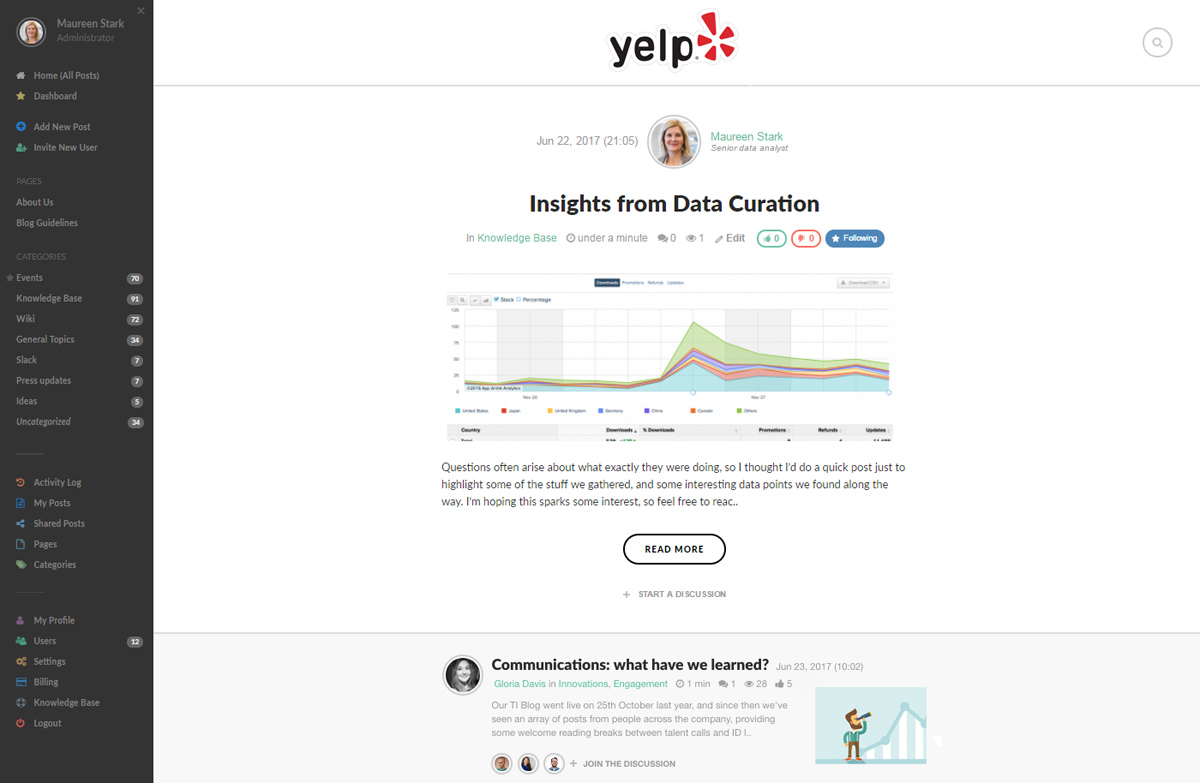
And employees are certainly feeling the need to connect. According to recent reports, 33% of millennials want collaborative workspaces, 37% of employees cite “working with a great team” as their primary reason for staying with a company, and 75% of workers rate teamwork and collaboration as “very important” in the workplace.
But why does team communication matter so much?
Today, we’ll be exploring exactly that, and introducing you to our top tools for helping teams collaborate from afar.
Why is team communication important
We’ve all heard the saying “communication is key”, and this is as true in business as it is in our personal relationships.
In fact, collaboration, communication, and transparency are right at the top of the most successful companies’ value statements. No one doubts the importance of team building in an organization, but the necessity to maintain the team and continually foster an environment where it can grow is sometimes overlooked.
Here are three of the biggest reasons why team communication should never be underestimated:
#1 It boosts morale and creates a healthy workplace culture
Communication fosters trust between teammates, and this creates an environment for positive professional relationships to take root and grow. When teammates know each other well, they become familiar with each other's strengths, weaknesses, and ways of thinking, which makes it easier to work together toward a common goal and plan for future projects.
Communication is also about creating a culture of celebration in the workplace.

Teammates and team leaders who notice the achievements of their peers and employees take the time to communicate and celebrate together. When people notice, congratulate, and encourage others on their improvement, they create an environment where employees want to be their best on the job and maintain a growth mindset.
This then adds a sense of fulfillment and satisfaction to the job, which can aid in employee retention and a stable work environment.
In fact, according to one report, 54% of employees say a strong sense of community (great coworkers, celebrating milestones, a common mission) kept them at a company longer than was in their best interest, while another study showed that companies and organizations that communicate effectively are 4.5 times more likely to retain the best employees.
#2 It strengthens innovation
Each member of your team will have different strengths and different ideas to bring to the table.
By communicating in the workplace, colleagues are able to bounce ideas off one another, inspire each other to see things from a different point of view, build on each others’ ideas, and correct others’ mistakes.
When teammates come together to collaborate on a project, they benefit from all of the strengths of everyone involved, creating quality work that they can all be proud to share.
#3 It increases productivity
When your team collaborates to establish realistic goals and objectives, work proceeds smoothly and efficiently.
This is because when everyone is clear on what they are supposed to be doing, and how their work contributes to the team’s overall success, they’ll feel more motivated to get stuck into their tasks - and more incentivized to do them well.
To illustrate this point, let’s take a look at what happens when teams don’t communicate. According to a survey of 400 corporations (with 100,000+ employees in the US and the UK), it was estimated that communication barriers cost the average organization $62.4 million per year in lost productivity.
With this in mind, teams who communicate openly and regularly set themselves up to be more productive, motivated, and profitable. Ultimately, transparency is one of the best ways to improve your bottom line.
How can you promote transparency at work?

When it comes to creating a strong culture of team collaboration, it goes without saying that you need to proactively communicate with your team.
Organizing daily team stand-ups (to discuss what you’re hoping to achieve), weekly roundups (to catch up on what has been done), celebrating individual and company-wide achievements, and organizing socials are just some popular methods that businesses employ to create an open and communicative workplace culture.
Another excellent way to facilitate transparency in the workplace is to find a great tool to facilitate hassle-free team collaboration.
Social collaboration tools allow teams to stay connected and work towards common goals without being physically present together in the workplace.
As the culture of remote working rises, more companies than ever are beginning to rely on these tools, with up to 80% of businesses using social collaboration tools to enhance their business processes.
Let’s take a look at some of the best:
Must-have tools for team communication in businesses
#1 Start knowledge sharing with Blogin
BlogIn is an internal company blog tool that you can use to share news, ideas, updates, announcements, learnings and even meeting notes with the rest of your team.
It’s the perfect tool to keep your team feeling connected and in the loop with one another - whether you’re working remotely or in an office.
BlogIn allows you to share far more in-depth information with your teammates than they could do with a chat tool alone, as it allows you to store and share long-form content, and archive it all in a searchable knowledge base.
So, if you’re looking to share internal news and knowledge, boost morale, maintain a healthy company culture, and help your team feel more connected, BlogIn is an ideal place to start!

#2 Arrange video conferences over Google Meet or Zoom
This might sound like a bit of an obvious one, as you’ve most likely spent a good part of 2020 in meetings, but Zoom has to get a mention on the list, as when it comes to feeling connected to people, you really can’t beat face-to-face interaction.
When you’re working remotely, it’s the closest thing you can get to meeting a colleague in person. And let’s face it - your team needs those little jokes and friendly catch-up conversations in order to feel connected to one another!
We’d recommend checking in with your teammates at least once daily to work through tasks together, set out your goals for the day, update each other on progress, or even just check in and say hello.
#3 Keep track of your team’s customer communications with Telbee
Another challenge of remote work is not being able to see what exactly your colleagues are working on. Luckily, social collaboration tools can help brands overcome this obstacle too.
Particularly for Sales and Customer Support teams, where many customer interactions are had privately over email or a video call, it’s important for colleagues to keep each other in the loop about who is communicating with which customer - so that they can ensure the right person is handling each query, and assess how they’re meeting their goals as a team.
One effective tool for this is Telbee, the app-free voice messaging solution for businesses.
Companies who sign up can create their own ‘voice recorder’, which they can display on their website. Visitors to their site can simply click a button to record a voice note for the brand. These voice notes are sent straight to the company’s shared ‘voice inbox’, where the whole team can listen to the voice messages (or read them transcribed), ‘claim’ the ones they feel ready to answer and assign voice notes to their colleagues.
Telbee lets your team see the conversations their teammates are currently involved in. It also provides employees with an efficient way to delegate tasks to exactly the right teammate, based on their individual strengths and areas of expertise.
#4 Check in with each other using an internal chat tool such as Slack
It goes without saying that to feel connected as a team, you need to have a quick and easy way to chat to and call each other.
Unlike email, conversations in Slack are easy to follow, and using this tool is the perfect way to check in with people directly, make audio calls, and send your colleagues quick updates.
Slack is our top choice for this category as it also integrates with many other useful social collaboration tools, such as BlogIn, the internal company blog platform.
#5 Keep track of each others’ schedules with Trello
Trello is a productivity platform that enables teams to organize and prioritize projects by laying tasks out in customizable boards, lists, and cards that the whole team can check off and share.
This tool lets employees dive into the details by adding comments, attachments, and due dates directly to Trello cards so that everyone gets a broad view of how company projects are going - and what their teammates are working on.
#6 Plan together with a digital whiteboard such as Miro
Miro is an online visual collaboration platform for teamwork. With Miro’s easy-to-use digital whiteboard, teams can draw, write notes, and add elements to the screen simultaneously. Better than your average whiteboard, Miro is an infinite canvas that helps you ideate, strategize and work with your team.
Teams can use Miro’s video conference feature, screen sharing, and presentation mode to run engaging visual meetings that go a few steps further than a Zoom call. You also don’t need to worry about lagging or delays, as Miro is lightning-fast, making it super easy for multiple people to work together at once.
It’s the perfect tool for design teams and visual thinkers looking to collaborate in real-time on projects, share ideas, and stay on the same page!
Final thoughts
Whether you’re looking to boost team morale, increase productivity, or up your business’s profitability, team communication is key.
We hope this list of social collaboration tools has given you some good ideas about what kind of software your team might benefit from this year - or at least got you thinking about how you can start creating a more collaborative, creative, and communicative environment for your team.
So go ahead and trial some of the tools we mentioned above. The only reason you’ll look back is to appreciate how far you’ve come!

 Esther Lowde is a Marketing Executive at telbee; the voice recording and messaging platform for business. A lover of writing, travelling and Digital Marketing, she is excited about helping businesses around the world improve their relationships with their customers through the power of voice.
Esther Lowde is a Marketing Executive at telbee; the voice recording and messaging platform for business. A lover of writing, travelling and Digital Marketing, she is excited about helping businesses around the world improve their relationships with their customers through the power of voice.